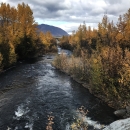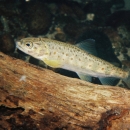States
MaineThe project to remove two dams—the Upper Town Dam and the Remnant Mill Dam—from the Sabattus River, a tributary to the Androscoggin River in Maine, has been successfully completed. Both dams were removed, accompanied by bank restoration, stabilization, and revegetation efforts.
These removals have eliminated public safety hazards, reduced flooding risk, and restored parks, providing safe access to nature for local communities. Additionally, the project has restored passage for federally endangered Atlantic salmon, river herring, and other species to important spawning habitats within the Androscoggin watershed.
Quick Facts:
| Project Status | Complete |
| Location | ME, Androscoggin |
| NFPP Project Funding | $350,000 |
| Restoration Techniques | Dam Removal |
| Accomplishments | 32.38 Stream Miles Reconnected |
| Project Partner Lead | Atlantic Salmon Federation |
| Primary Species Benefited | Alewife |
The National Fish Passage Program combines technical expertise with a track record of success.
Implemented primarily through the Service's Fish and Wildlife Conservation Offices, the National Fish Passage Program provides financial and technical assistance to partners across the country. Since 1999, the program has worked with over 2,000 local communities, Tribes, and private landowners to remove or bypass over 3,400 barriers to fish passage and reopen access to over 61,000 miles of upstream habitat for fish and other animals. Staff have expertise in fish migration and biology as well as financial, engineering, and planning assistance to communities, Tribes, and landowners to help them remove barriers and restore rivers for the benefit both fish and people.
Fish passage project proposals can be initiated by any individual, organization, government, or agency. However, proposals must be submitted and completed in cooperation with a Fish and Wildlife Conservation Office. (Please note that fish passage projects being used for federal or state compensatory mitigation or required by existing federal or state regulatory programs are not eligible for funding through the National Fish Passage Program.)









